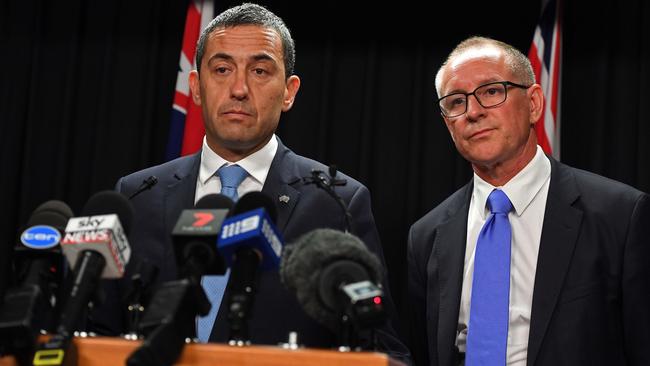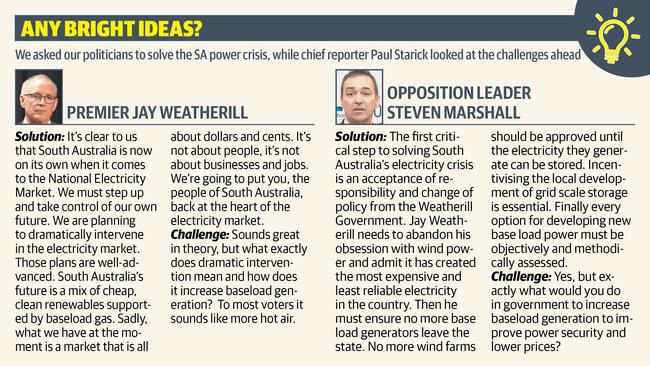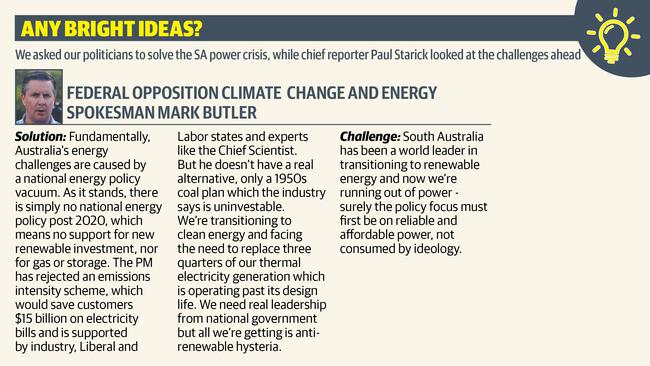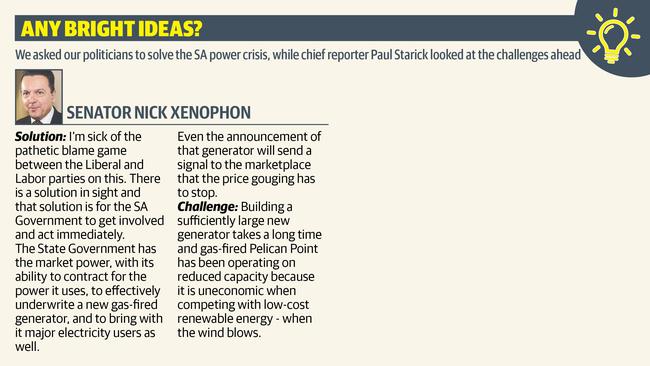Blame game over rolling blackouts as South Australia promised dramatic overhaul of energy grid
SOUTH Australia’s blackouts have been branded “hiccups” by Federal Labor climate change spokesman Mark Butler.
SA News
Don't miss out on the headlines from SA News. Followed categories will be added to My News.
- SMACKDOWN: PM calls Weatherill ‘lazy, hypocritical’ on power
- RESPONSE How the State Government plans to fix energy crisis
- HIT LIST: Is your area on the blackout hit list?
- ANALYSIS: No easy fix to SA’s power crisis
- YOUR REACTION: People angry and frustrated by power cuts
SOUTH Australia’s blackouts have been branded “hiccups” by Federal Labor climate change spokesman Mark Butler.
The Port Adelaide MP and national Labor president is accusing the Federal Government of seizing upon the load shedding to 90,000 homes and businesses on Wednesday night for political purposes.
“What you have really is a government which seeks to jump on every little hiccup, and every big hiccup, in the electricity system and somehow shoot it home to renewable energy policy,” Mr Butler told ABC radio.
“In fact, what has happened in South Australia — a very, very bad run in South Australia over several months — on each occasion has had nothing to do with renewable energy.”
Mr Butler said there was no supply problem in SA, because the state had enough generation to meet demand.
Instead, he said the load shedding would have been avoided if the Australian Energy Market Operator (AEMO) had directed the gas-fired Pelican Point plant to operate a second generator.
Pelican Point was ordered to fire up the generator on Thursday afternoon, which meant that the state avoided further rolling blackouts on Thursday evening.


Opposition Leader Steven Marshall said on Friday the Government must do everything it could to “press the pause button” on the demolition of Port Augusta’s Northern Power Station and take nothing off the table in its quest for energy security.
“Maybe the infrastructure at Port Augusta can be used for new technology, what we’re saying is don’t take anything off the table,” he said.
He said the Government had a history of “talking tough and failing to deliver” on energy and South Australians should be distrustful of their plan to lower energy prices.
State Energy Minister Tom Koutsantonis said on Friday AEMO had “serious questions” to answer before a Senate inquiry today, but refused to reveal more about the “dramatic market intervention” he has promised.
Mr Koutsantonis said only that it would require taxpayer expenditure and would be released “very, very soon”.
“We’ll make that announcement when we’re ready. We’re not going to come out and speculate about it, obviously we want to make sure we have a plan we can give South Australians that they can look at, that they can hold up and they can understand exactly how we will impact into the market and what the impact will be on them,” he said.
Mr Koutsantonis said the Federal Government needed to answer why it took potential load shedding in Sydney on Friday to have a national conversation about the energy market.
He said AEMO’s failure to urge Pelican Point to turn on in time to avoid a load shedding incident pointed to a “demand management, it’s a failure of managing weather and conditions and what’s going on in the market”.
Premier Jay Weatherill declared Wednesday’s blackout — which followed September’s statewide outage and comes as household bills soar — to be “totally and utterly unacceptable”.
Mr Weatherill said on Thursday he had concluded the state had been abandoned by the national electricity market and he was preparing plans for SA “to take control of our own future”.
He would not expand on details, but said the Government hoped to trigger construction of a new gas-fired power station with a bulk-buy public sector power contract recently sent for tender.
It is understood the Government is also closely examining plans for new interconnectors to other states, which would allow exports of green energy and more back-up in times of peak demand.
“One thing that is absolutely clear to us is that SA is now on its own in relation to the national electricity market. It’s on its own because the national Energy Market Operator is unable to run a system which can guarantee us security of electricity supply,” Mr Weatherill said.

“We have to step up and take control of our own future, and we are determined to do that.
“The SA Government has been planning to intervene dramatically in the SA electricity market.
“We’re going to put people back in the middle of this electricity market.”
Mr Turnbull said SA’s renewable energy policy had opened the state up to unacceptable risk.
“The absurdity, the irony of this is it means SA is relying more and more heavily on Victoria, on the interconnector ... and the energy they’re importing from Victoria is generated by brown coal.
“They have a higher emissions intensity than the (Port Augusta) northern power station did that has been closed down.
“If you want to have a larger and larger share of intermittent renewables in your energy system then you need to have the backup ... when the wind isn’t blowing.
“What Weatherill has done, in a very lazy and complacent way, is just assume you can draw more and more energy from Victoria. It just shows the complacent mindlessness of the State Government.”
Grattan Institute Energy Program director Tony Wood said it was now clear that AEMO did not know how to manage the grid, which has growing renewable input.
“Both last year (when the state went black) and yesterday, they (AEMO) made a decision and the end result was a choice between cost and security and they chose cost in both cases,” he said.
“As Donald Trump would tweet, that was ‘dumb’. I would have thought considering the last nine months, they would be erring on the side of extreme caution.”
As NSW prepares for a sweltering day, prompting warnings from AEMO that it could also face load shedding, Mr Wood said it would be “bizarre” the operator was not “far more cautious” about trying to avoid the lights going out in the country’s most populated city.
AEMO media and corporate affairs group manager Stuart Allott said the decision not to fire up Pelican Point was made by senior staff within the control rooms of the operator and generator.
“AEMO proactively called Pelican Point to understand what their ramp-up time was and it was determined that it would not meet market demand. It’s not as simple as just flicking on a switch,” he said.
“Load shedding is treated as a last resort but it's a controlled mechanism to maintain system security.”
Mr Allott said the call was made within a matter of hours before the load shedding was required but that the gas generator was unable to fire up quickly enough to prevent it.
He defended the operator’s handling of Wednesday, explaining that it acts within rules and policies which it does not set itself.
Independent Senator Nick Xenophon said the State Government must underwrite a new gas power station to deliver energy security and lower prices for consumers.
“These events are yet another reminder of market failure in our electricity sector, with enormous impacts on residential consumers and businesses,” he said.
“I’m sick of the pathetic blame game between the Liberal and Labor parties. “There is a solution in sight and that solution is for the SA Government to get involved and act immediately.”




So what went wrong on Wednesday night with SA’s power?
How does the national energy market work?
The national energy grid links states through a series of interconnectors. Because electricity cannot be stored easily, the national market works as a pool where power supply is matched with demand instantaneously. Generators offer to supply the market with specified amounts of electricity at specified prices for set periods and can make offers at any time. The Australian Energy Market Operator then decides which generators switch on, with the cheapest generator put into operation first. As price dictates where energy is generated, in SA, once electricity demand outstrips wind and solar production, energy tends to be imported from Victoria’s coal generators because it’s cheaper than electricity produced locally using gas.
Who is AEMO?
The Australian Energy Market Operator is a body set up by the Government to manage the national energy market, which interconnects Queensland, NSW, the ACT, Victoria, SA and Tasmania. It is responsible for ensuring enough energy is generated to satisfy demand and that the system is stable. When infrastructure faults have the potential to shut down the system, AEMO decides how the grid should respond to minimise the areas where supply is cut.
How do they make these decisions?
AEMO is governed by a series of rules, policies and processes set by the Government. The operator constantly monitors weather conditions to determine whether it needs to direct the market to switch generators on or off or to restrict the flow of energy over the interconnector. It also uses an algorithm to estimate the future level of wind generation.
What happened on Wednesday night?
AEMO notified the market on Wednesday at midday that it was forecasting supply to be extremely tight, giving notice to generators that were switched off that they may want to turn on. As the day went on and it became clearer there could be a shortage of supply, AEMO contacted the operators of Pelican Point — and all other generators in the state — to investigate whether it could turn on its second unit to cover a possible shortage. However, during that conversation between control room operators, which happened less than an hour before the blackout, it became clear that it was not able to get up and running in time, so the decision was made not to direct the generator into the market. About 90,000 homes and businesses went without power for half an hour. As temperatures soared, demand for electricity rose to near-record levels. However, generation from wind — which can provide up to 50 per cent of the state’s power — dropped to 2.5 per cent because the wind stopped blowing.
Do we have enough energy supply?
It appears so. Yesterday, the Australian Energy Market Operator ordered a second turbine at Pelican Point to fire up and cut the risk of more rolling blackouts. However, SA relies on Victoria for about a third of its power at peak demand. The wind also wasn’t blowing and solar panels began to reduce production at the time of the blackout and couldn’t be relied on.
Is it likely to happen again?
Maybe. The current heatwave means the state needs every bit of power it can find to get through. However, if wind isn’t available or there is an issue with thermal generation like gas, the state is pushing the system to the limit. If the interconnector to Victoria fails, we’re in big trouble. Things could get even more difficult later this year following the closure of Victoria’s Hazelwood coal-fired power station.
Are renewables to blame?
Yes and no. The problem with wind farms and solar is they only work when it’s windy or sunny. Wind farms also disrupt the market and make it harder for reliable coal and gas power stations to remain viable. It appears that on Wednesday the state could have made it through, without relying on wind or solar, if the system was managed differently.
What is the difference between this power outage and the previous ones?
Unlike Wednesday’s blackout, freak storms were the root cause of the blackouts earlier this summer. However, some have questioned if these storms were all really as unusual as the Government would have you believe.
Timeline — How we got to this point
JUNE 2015 — Alinta Energy announces its plans to close the coal-fired Northern Power Station in Port Augusta.
Energy Supply Association warns impending closure of Northern will result in higher prices and an increased blackout risk.
NOVEMBER 1, 2015 — About 110,000 South Australian houses and businesses plunged into darkness for three hours after the Victorian interconnector failed.
NOVEMBER 2015 — Deloitte releases a report finding SA is “at the cutting edge of contemporary electricity grids” but finds exit of baseload generation from the state shows available capacity may be insufficient to meet electricity demand by 2017.
MAY 2016 — Northern Power Station closes.
SEPTEMBER 28, 2016 — All of SA blacked out after tornadoes destroyed critical power infrastructure, multiple wind farms shut down and the Victorian interconnector is tripped. Most customers were without power for less than eight hours, but the blackout lasted several days in regional areas and cost business $367m.
OCTOBER 2016 — The Advertiser reveals the Australian Energy Market Operator identified challenges faced by SA in using wind power while maintaining system stability in a 2014 report.
NOVEMBER 2016 — Engie announces closure of its Victorian Hazelwood Power Station by March 2017.
NOVEMBER 30, 2016 — SA disconnects from Victorian interconnector, plunging 200,000 homes into darkness for hours overnight.
DECEMBER 27, 2016 — Massive storm lashes the state, damaging distribution infrastructure and leaving 155,000 households without power for extended periods. Some Adelaide Hills businesses and households left without electricity for more than four days.
JANUARY 20, 2017 — 74,000 lightning strikes and wind gusts of more than 110km/h hit SA, damaging infrastructure and leaving 58,000 businesses and households without power.
FEBRUARY 8, 2017 — More than 90,000 households and businesses had their power deliberately cut as AEMO ordered load-shedding.


